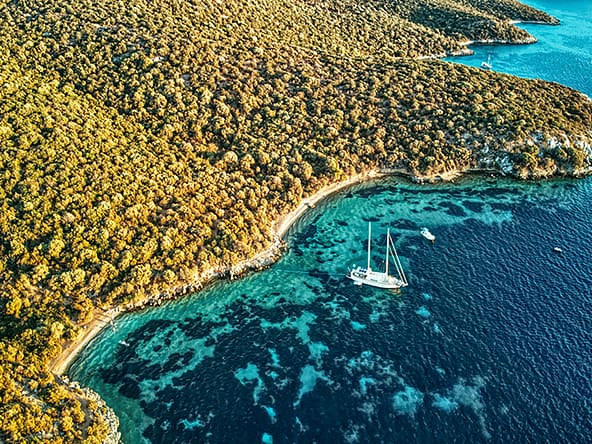Digital nomadism is becoming more and more popular these days, but Turkey has long been a
stronghold of nomadic thought and cultural customs, making it an excellent model of the nomadic lifestyle of today. Since the Turks have always been a nomadic people, they have lived a protracted, centuries-long nomadic existence. The sixth century saw the activity of the first known nomads.
While some Turkic groups remained nomadic until relatively recently, with a few traditional groups carrying on the practice now, others settled in various places over time, adjusting to changing conditions and environments.
Although it is true that there is very little nomadic life in modern Turkey, there are still certain aspects of Turkish culture that are deeply established in the country’s psyche, and the majority of them have nomadic forebears. Turks still carry out some of the customs of their nomadic forefathers, even though the practice of moving in packs has largely disappeared. What is it like to be a nomad?
A nomad’s lifestyle
Nomads are characterised by their perpetual motion; they frequently relocate in accordance with seasonal cycles to locate resources or graze animals. Their homes are ready to assemble and transportable. Traditionally, the Turks inhabited felt yurts, which were portable and quickly erected wherever they lived. These structures offered enough warmth and protection from the weather.
Additionally, most digital nomads don’t have permanent residences; instead, they seek out enough lodging and remain there for as long as necessary. This could involve renting a private or shared flat, staying longer on Airbnb, or booking hotels during or outside of the off-season.
A nomad’s adventure
It is labour-intensive to travel about, and although Turks today, like digital nomads, may not rely on their frequent movements for a living, this is not necessarily the case for nomadic people in the past.
In the past, the necessity to locate new pastures and water supplies for their animals frequently controlled mobility. In Turkey, many families alternated between two residences, which they obtained either via summer houses or by entering the communities of their ancestors.
Turks are still relocating frequently, and many of them lead double lives as a result of their dual residences. Because they don’t want to carry anything with them, they are actually more minimalist than other Western civilizations.
Nomads adapt to changing environments
Cultures that are nomadic can adjust to shifting conditions. They get a thorough awareness of the terrain, the weather, and the resources that are accessible to them, which enables them to flourish in a variety of environments. Today’s digital nomads might choose to build their living arrangements on the local environment and seasonal conditions, just like the nomads of the past.
A digital nomad might be living in the middle of ski country, covered in snow, one day, and enjoying the summertime in a different part of the hemisphere the next. Because of their ability to adapt, nomads are able to live anywhere they choose and do so in a fulfilling way.
What are their survival skills like?
For survival, nomadic communities frequently rely on their abilities and resources. To reduce their reliance on outside resources, they might manufacture their own food, clothes, and equipment. Although they are minimalists, nomads are also sensible people who just bring what they need and know how to use. Additionally, they pay attention to taking care of themselves and are more resilient to changes in the environment and climate.
Nomads live a healthy lifestyle
Digital nomads also have more option to prioritise physical experiences and exercise, whereas
traditional nomads exercised formally as part of their lifestyle, walking for days on end and carrying everything with them.
Similar to historical nomads who lived off the land and ate healthily, digital nomads place a strong emphasis on their well-being since, after all, isn’t it why they selected this lifestyle in the first place?Exercise also fosters social connections for modern nomads; whether they are walking, running, or participating in a local yoga class, exercise encourages the formation of new acquaintances when travelling constantly.
Nomads need to be resourceful
When it comes to locating and using things from their surroundings, nomads become resourceful. Natural resources are frequently used by them to manufacture tools, clothes, and shelter. Because they have to carry their stuff with them when they migrate, nomads typically have a minimalistic attitude towards material possessions.
Both traditional and digital methods must be flexible enough to adjust to shifting conditions, including weather and unforeseen obstacles that may develop while travelling.
They have the ability to adapt, be impulsive, and tolerate abrupt changes in the circumstances. Rather, they figure out how to get by and quickly return to being a happy group. Because the modern nomad continuously seeks out new experiences and places, it also necessitates adaptation and lower expectations.
Communal living for nomads and shared responsibilities
Communities of nomads frequently have a strong sense of community, with members sharing duties and leading cooperative lives. Collaboration is essential for surviving in difficult situations.
While living a nomadic lifestyle today is far more solitary than it was in the past, many contemporary nomads place a high value on residing in communities of other nomads and strive to forge deeper, more meaningful connections with people—something that technology these days aids in.
Nomad’s movements follow the seasons
Seasonal migration is a common pattern followed by nomads, who relocate to regions that are ideal for their livestock at particular periods of the year. Since they are free to live anywhere they choose, digital nomads frequently choose areas with mild weather, but this varies depending on the season. Both ancient and contemporary nomads lead a non-sedentary lifestyle that is defined by frequent or continuous relocation.
Do nomads have a connection to the natural world?
The natural world is typically deeply connected to nomadic civilizations. Their ability to comprehend and appreciate the environment, which includes animal behaviour and weather patterns, is essential to their survival.
Both kinds of nomads keep a connection to their environment; however the kind of relationship may be different. While digital nomads frequently look for natural settings and habitats for their nomadic lifestyle and remote work, traditional nomads possess a profound grasp of these areas.
The fundamental ideas of movement, adaptability, and connectivity to the outside world endure in both conventional and digital nomadic communities, despite the change of nomadic lifestyles in the digital age. Both conventional and digital nomads lead nomadic lifestyles, but the digital nomad way of life is influenced by the opportunities and difficulties brought about by the digital era, which has made it possible for a new kind of nomadism to emerge that is focused on connectivity and remote employment.
Please click the link if you wish to buy a property in Turkey.





